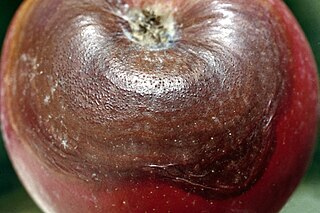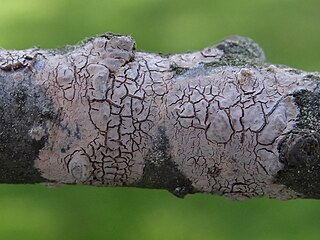
The pathogenic fungus Cryphonectria parasitica is a member of the Ascomycota. This necrotrophic fungus is native to East Asia and South East Asia and was introduced into Europe and North America in the early 1900s. The fungus spread rapidly and caused significant tree loss in both regions.

The parsnip is a root vegetable closely related to carrot and parsley, all belonging to the flowering plant family Apiaceae. It is a biennial plant usually grown as an annual. Its long taproot has cream-colored skin and flesh, and, left in the ground to mature, becomes sweeter in flavor after winter frosts. In its first growing season, the plant has a rosette of pinnate, mid-green leaves. If unharvested, it produces a flowering stem topped by an umbel of small yellow flowers in its second growing season, later producing pale brown, flat, winged seeds. By this time, the stem has become woody, and the tap root inedible. Precautions should be taken when handling the stems and foliage, as parsnip sap can cause a skin rash or even blindness if exposed to sunlight after handling.

Phytophthora is a genus of plant-damaging oomycetes, whose member species are capable of causing enormous economic losses on crops worldwide, as well as environmental damage in natural ecosystems. The cell wall of Phytophthora is made up of cellulose. The genus was first described by Heinrich Anton de Bary in 1875. Approximately 210 species have been described, although 100–500 undiscovered Phytophthora species are estimated to exist.

Juglans cinerea, commonly known as butternut or white walnut, is a species of walnut native to the eastern United States and southeast Canada.

A plant canker is a small area of dead tissue, which grows slowly, often over years. Some cankers are of only minor consequence, but others are ultimately lethal and therefore can have major economic implications for agriculture and horticulture. Their causes include a wide range of organisms as fungi, bacteria, mycoplasmas and viruses. The majority of canker-causing organisms are bound to a unique host species or genus, but a few will attack other plants. Weather and animal damage can also cause stress to the plant resulting in cankers. Other causes of cankers is pruning when the bark is wet or using un-sterilized tools.

Diplodia tip blight, also known as Sphaeropsis blight, is a widespread disease affecting conifers caused by an opportunistic fungal pathogen, Diplodia sapinea. It is found in “both hemispheres between the latitudes 30° and 50° north and south". The diseases symptoms include: damping off and collar rot of seedlings, stem canker, root disease, and, most commonly, shoot blight. These symptoms have caused significant economic loss to nurseries and pine plantations. In a nursery in the north-central United States, losses of 35% have been reported. Shoot blight and eventual die back can cause a reduction of marketable volume in timber by 63%. Infection of terminal shoots can result in dead-top which significantly limits the usable length of the tree trunk. The presence of the pathogen in concert with severe weather conditions can lead to extreme loss. Following a severe hailstorm in South Africa, nearly 5,000 acres of pine plantation were infected with Diplodia tip blight. It was necessary to prematurely harvest large swaths of the plantations resulting in a loss of 45%. Areas that were not harvested prematurely still suffered an average timber loss of 11%.

Rhizoctonia solani is a species of fungus in the order Cantharellales. Basidiocarps are thin, effused, and web-like, but the fungus is more typically encountered in its anamorphic state, as hyphae and sclerotia. The name Rhizoctonia solani is currently applied to a complex of related species that await further research. In its wide sense, Rhizoctonia solani is a facultative plant pathogen with a wide host range and worldwide distribution. It causes various plant diseases such as root rot, damping off, and wire stem. It can also form mycorrhizal associations with orchids.

Botryosphaeria obtusa is a plant pathogen that causes frogeye leaf spot, black rot and cankers on many plant species. On the leaf it is referred to as frogeye leaf spot; this phase typically affects tree and shrubs. In fruit such as the apple, cranberry and quince, it is referred to as black rot, and in twigs and trunks it causes cankers.

Nectria cinnabarina, also known as coral spot, is a plant pathogen that causes cankers on broadleaf trees. This disease is polycyclic and infects trees in the cool temperate regions of the Northern Hemisphere. N. cinnabarina is typically saprophytic, but will act as a weak parasite if presented with an opportunity via wounds in the tree or other stressors that weaken the tree's defense to the disease. A study published in 2011 showed that this complex consists of at least 4 distinct species. There are only a few ways to manage this disease with techniques such as sanitation and pruning away branches that have the cankers. N. cinnabarina is not as significant a problem as other Nectria spp., some of which are the most important pathogens to infect hardwood trees.
Erythricium salmonicolor is a species of fungus in the family Corticiaceae. Basidiocarps are effused, corticioid, smooth, and pinkish and grow on wood. The fungus is a commercially significant plant pathogen which has become a serious problem, especially in Brazil. Erythricium salmonicolor causes Pink Disease, most commonly in Citrus, although E. salmonicolor has a wide host range including rubber and cacao trees. Pink Disease causes branch and stem die-back due to canker formation. The cankers are recognizable by gum exudation and longitudinal splitting of the bark.

Botryosphaeria stevensii is a fungal plant pathogen that causes cankers on several tree species including apple and juniper as well as causing cankers on grape vines. It causes branch dieback, possibly affecting a large portion of the tree canopy, and if severe it can kill entire plants.

Diaporthe helianthi is a fungal pathogen that causes Phomopsis stem canker of sunflowers. In sunflowers, Phomopsis helianthi is the causative agent behind stem canker. Its primary symptom is the production of large canker lesions on the stems of sunflower plants. These lesions can eventually lead to lodging and plant death. This disease has been shown to be particularly devastating in southern and eastern regions of Europe, although it can also be found in the United States and Australia. While cultural control practices are the primary method of controlling for Stem Canker, there have been a few resistant cultivars developed in regions of Europe where the disease is most severe.

Peniophora cinerea is a species of fungus in the family Peniophoraceae. It is a plant pathogen infecting black walnut.
The plant pathogenic fungus Leucostoma kunzei is the causal agent of Leucostoma canker, a disease of spruce trees found in the Northern Hemisphere, predominantly on Norway spruce and Colorado blue spruce. This disease is one of the most common and detrimental stem diseases of Picea species in the northeastern United States, yet it also affects other coniferous species. Rarely does it kill its host tree; however, the disease does disfigure by killing host branches and causing resin exudation from perennial lesions on branches or trunks.

Didymella bryoniae, syn. Mycosphaerella melonis, is an ascomycete fungal plant pathogen that causes gummy stem blight on the family Cucurbitaceae, which includes cantaloupe, cucumber, muskmelon and watermelon plants. The anamorph/asexual stage for this fungus is called Phoma cucurbitacearum. When this pathogen infects the fruit of cucurbits it is called black rot.

Entoloma haastii is a mushroom in the Entolomataceae family. Described as new to science in 1964, it is known only from New Zealand, where it grows on the ground in leaf litter, usually near Nothofagus species.

Fusarium circinatum is a fungal plant pathogen that causes the serious disease pitch canker on pine trees and Douglas firs. The most common hosts of the pathogen include slash pine, loblolly pine, Monterey pine, Mexican weeping pine, and Douglas fir. Like other Fusarium species in the phylum Ascomycota, it is the asexual reproductive state of the fungus and has a teleomorph, Gibberella circinata.

Eriosoma lanigerum, the woolly apple aphid, woolly aphid or American blight, is an aphid in the superfamily Aphidoidea in the order Hemiptera. It is a true bug and sucks sap from plants.

Neoscytalidium dimidiatum was first described in 1933 as Hendersonula toruloidea from diseased orchard trees in Egypt. Decades later, it was determined to be a causative agent of human dermatomycosis-like infections and foot infections predominantly in tropical areas; however the fungus is considered to be widespread. A newer name, Scytalidium dimidiatum, was applied to a synanamorph of Nattrassia mangiferae, otherwise known as Neofusicoccum mangiferae. Substantial confusion has arisen in the literature on this fungus resulting from the use of multiple different names including Torula dimidiata, Fusicoccum dimidiatum, Scytalidium dimidiatum, and Hendersonula toruloidea. Additionally, Scytalidium lignicola and Scytalidium lignicolum are often considered earlier names of N. dimidiatum.
















